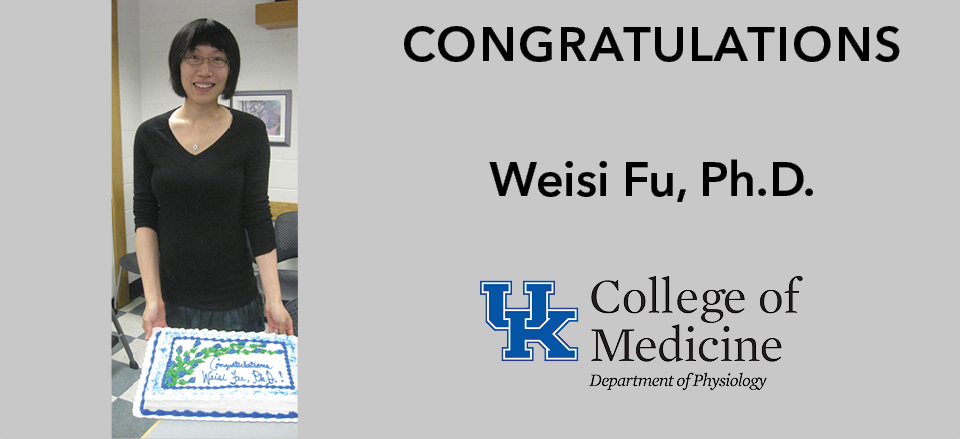Congratulations Weisi Fu, PhD
Weisi Fu successfully defended her dissertation on Thursday, September 29, 2016
Doctoral Committee Members
Dr. Bradley K. Taylor
Mentor, Department of Physiology
Dr. Karin W. High
Department of Physiology
Dr. Gregory Frolenkov
Department of Physiology
Dr. Kimberly Nixon
Department of Pharmaceutical Sciences
Outside Examiner
Dr. Gregory Bix
Department of Anatomy & Neurobiology
Abstract of Dissertation
Inflammation or nerve injury sensitizes several populations of nociceptive neurons in the dorsal horn of the spinal cord, including those that express the neuropeptide Y (NPY) Y1 receptor (Y1R). Our overall hypothesis is that after tissue or nerve injury, these Y1R- expressing neurons enter a state of latent sensitization (LS) that contributes to vulnerability to the development of chronic pain; furthermore, LS is under the tonic inhibitory control of endogenous NPY release. To determine whether Y1R-expressing neurons acquire a pain enhancing phenotype after peripheral nerve injury, we asked whether nerve transection increased the co-expression of Y1R with markers of excitatory and inhibitory neurons; we found that nerve injury changes the co-expression patterns of Y1R with neuronal markers. To determine the intracellular signaling pathways that become activated in Y1R-expressing neurons, we used chronic pain models that first involved tissue or nerve injury, allowed pain hypersensitivity to resolve, and then administered the Y1R receptor antagonist, BIBO3304 during pain remission so as to reinstate pain hypersensitivity. As observed previously with mu-opioid receptor constitutive activity, we used BIBO3304 to show that endogenous NPY-Y1R signaling silences an N-methyl-D-aspartate receptor (NMDAR)- adenylyl cyclase type 1 (AC1) mechanism of LS. We also used BIBO3304 to show that LS is driven by multiple signaling pathways downstream of AC1. The first was protein kinase A (PKA) and transient receptor potential cation channel A1 (TRPA1) and channel V1 (TRPV1). The second were exchange proteins activated by cAMP (Epac 1 and Epac 2). In a separate set of experiments that utilized Y1R-receptor internalization as an index of NPY release, we found that nerve injury increased stimulus evoked NPY release. We speculate that injury not only generates LS, but also up-regulates a compensatory increase of NPY release. These results present a novel mechanism of injury-induced LS and endogenous control of the transition from acute to chronic pain by the NPY-Y1R system. Our work sheds light on novel targets for the treatment of chronic pain. The results of this dissertation suggest that MC1R signaling could be augmented in individuals to prevent UV induced damage.
Acknowledgements from Dr. Fu
I would like to express my deep appreciation and gratitude to my PhD advisor, Dr. Bradley K. Taylor, for his patient guidance and mentorship from my first rotation with him through the completion of this degree. Dr. Taylor’s intellectual heft is matched only by his genuinely good nature, and I am truly fortunate to have had the opportunity to work with him. I would also like to thank my committee members, Drs. Karin W. High, Gregory Frolenkov and Kimberly Nixon for the valuable guidance, thought-provoking suggestions and friendly encouragement that they offered me over the years. In a similar vein, I would like to recognize Renee Donahue, Drs. Suzanne Doolen, Gregory Corder, Ryan Griggs, and Sinha Ghanshyam for the contributions that each of them made to my intellectual growth during my years of work at Taylor lab. Finally, I would like to thank my husband, Xia Yu, for supporting me in any possible way as always.
